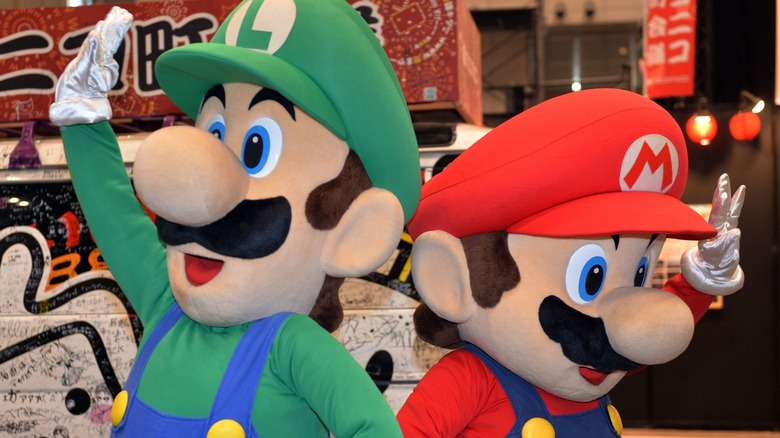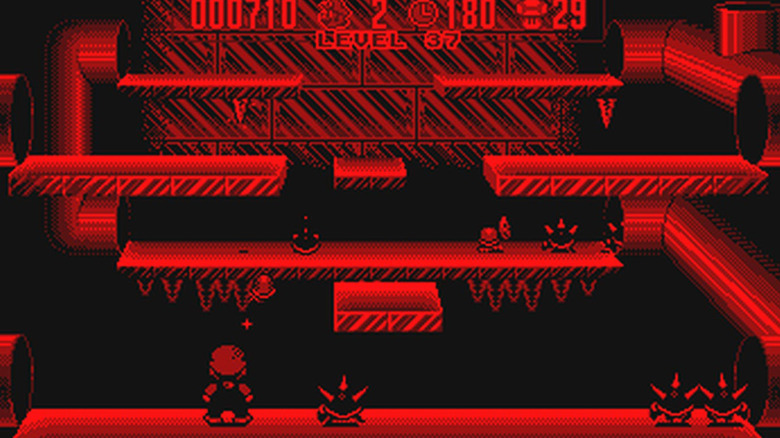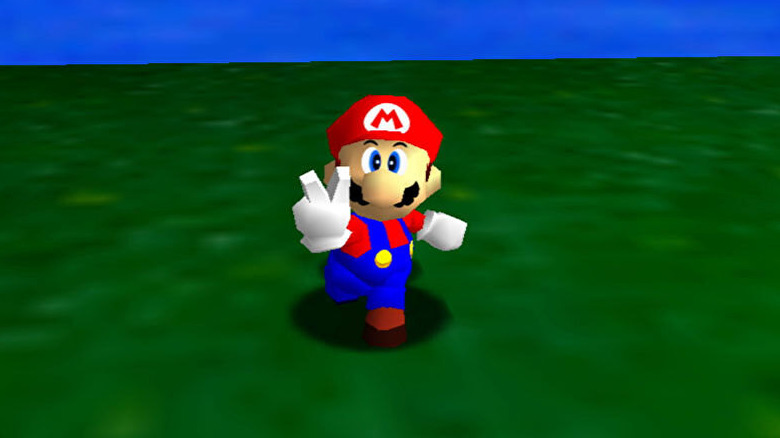Gaming Flops That Nintendo Was Sure Would Be A Hit
When you think about Nintendo, the things that come to mind are likely the company's successes. Things like the absolute dominance of the console market in the late '80s and early '90s, beloved franchises like Zelda and Metroid, the fact that they made a mustachioed plumber into a beloved worldwide icon, and the unstoppable merchandising juggernaut that is Pokémon. For a company that got its start making playing cards, that's not a bad track record.
But Nintendo's been around for a real long time, and while they've had their share of wins, they've taken some pretty massive missteps along the way. Check out these flops that Nintendo was sure was going to be a hit.
Virtual Boy's real failure
Nintendo's best-known failure should've been a hit, at least judging by its pedigree. The Virtual Boy was, after all, created by Gunpei Yokoi. A long-time Nintendo employee who got his start as a maintenance engineer, Yokoi actually created Nintendo's first toy, the Ultra Hand. When the company moved into video games, Yokoi designed the Game & Watch and the Game Boy, produced Donkey Kong and Metroid, and even designed the cross-shaped controller D-Pad.
In 1994, though, Nintendo set their sights on the hot new world of virtual reality, and wound up putting the worst possible exclamation point on Yokoi's genuinely incredible career with the company. The basic idea of the new console was to give gamers a "3D" experience by having them shove their faces into a headset that projected visuals into each eyepiece to give the illusion of depth. Nintendo made a huge PR push, previewing the console in The New York Times and partnering with Blockbuster Video for demo sets and low-cost rentals that were meant to excite public about a whole new world of gaming possibilities.
Unfortunately, the hardware didn't live up to the hype. Not only did the Virtual Boy require you to sit uncomfortably at a table and lean into what was essentially a next-generation View-Master, the limitations of technology meant that a color display was too blurry to work. Instead, Yokoi went with laser red, citing the fact that it was easier to see, which is why it's used for traffic lights. The end result was a console that was all the fun of staring at a traffic light with the added thrills of back pain.
It performed about as well as you'd expect. With low sales that amounted to fewer than 800,000 consoles shipped worldwide, the Virtual Boy was discontinued less than a year after its release.
Nintendo's early 3DS headaches
Make no mistake, the 3DS is great. As the replacement for the DS, the company's latest handheld offered up a more sensitive touch screen, a 3D camera, an expansive library of Virtual Console games, and some fantastic games, from Smash Bros. to The Legend of Zelda: A Link Between Worlds, and even a portable Mario Maker. It's even been a huge commercial success, racking up almost 69,000,000 sales. Nice.
But it also had a rough start. The original price tag of $249 prompted "disappointing sales" and a huge price cut after tanking the company's profits in 2011. It's easy to see why it didn't catch on at first, too, since it had one of the most useless gimmicks of all time. As the name implies, the entire selling point of the system — beyond the fact that it's the newest one, and therefore the one that will allow you to play the next generation of Pokémon games — was its 3D functionality. The problem? It turned out that Nintendo's Virtual Boy-era concerns about how a fully 3D color display would be blurry, muddy, and headache inducing turned out to be as well-founded in 2011 as they had been in 1994.
While other Nintendo systems had shoehorned in their gimmicks to varying degrees of success — like the Wii's tendency to add completely unnecessary motion controls to cross-platform titles — the 3D graphics of the 3DS often actively made games worse. Fortunately, the system came with an option to reduce the 3D effects or turn them off completely. In the end, Nintendo had to admit that it was a pretty unnecessary element with the introduction of the cheaper 2DS handheld. Still, that's a lot of effort for something that was ultimately better off ignored.
Wii U? More like Pee-Yoo
After its release in 2006, the Wii became a massive success, breaking records for the most consoles sold in a single month on its way to selling over 100,000,000 units and bringing gaming to entirely new audiences. Its successor, the Wii U, on the other hand... not so much.
To its credit, the Wii U was an interesting console, mixing things up with a controller that served as both a secondary display and a touchscreen, potentially bringing the different types of controls gamers had seen on the DS to a full console. It even wound up having a library that included some great titles, from the usual Zeldas and Marios to action games like Bayonetta to the incredibly innovative Super Mario Maker — which, by virtue of giving players a theoretically infinite number of new Super Mario Bros. 3 levels, has a claim on being one of the best games of all time.
At the end of the day, though, it wasn't enough. The Wii U was completely outmatched by its competitors from Sony and Microsoft, and its handful of great titles couldn't compete with the extensive lineups that were available on other platforms. By the end of its four-year lifespan, the Wii U sold only 13,000,000 units, a fraction of the Wii's success. It had, however, served as the stepping stone to the Switch, a console that would take all of the Wii U's innovations and do them a whole lot better.
R.O.B.: A successfully useless NES accessory
On one level, the Robotic Operating Buddy was actually a huge success. After the video game crash of 1983 had devastated both the game market itself and the public's interest in gaming consoles, Nintendo hatched a strategy to classify their new "Entertainment System" as a new kind of toy, and not a game console. R.O.B. was part of that, a physical piece of the NES Deluxe Set that was very identifiable as a traditional toy, which was supposed to give consumers the idea that this was something a little more sophisticated than, say, E.T. for the Atari 2600. And amazingly, it worked.
Well, the idea worked, at least. The actual toy left a lot to be desired. R.O.B. was only ever meant to work with two games, Gyromite and Stack-Up. Neither game is great, and the addition of R.O.B.'s achingly slow contributions as a necessary element for playing them wasn't exactly fun — especially when you consider that the NES already had a game like Super Mario Bros., which was so unlike any other video game up to that point that it literally redefined what games could be.
As the marketing equivalent of a Trojan Horse that was meant to get people more interested in the console, R.O.B. worked. As an actual gaming peripheral, however, that thing ranks somewhere between the Power Pad that you had to use for the NES Track and Field and a regular controller that you tried to play with your feet instead of your hands.
N64's Hey You, Pikachu made gamers yell...then cry
Ever since the Pokémon games made their debut on the Game Boy in 1996, gamers clamored for a full-sized console release. What Japanese gamers got in 1998, however — and what American audiences would get two years later — was Hey You, Pikachu!
As one of two games to use the Nintendo 64's Voice Recognition Unit, Hey You swapped out all the fun of journeying through a region and catching wild Pokémon with the thrill of trying to get Pikachu to understand that you were talking to him. If you did, you were able to gather ingredients for other Pokémon to make lunch, which isn't quite as fun as, say, battling Team Rocket.
The most messed up part, though? Hey, You lets you pal around with Pikachu for 365 in-game days, and then Professor Oak makes you take him out to the woods and tell him you don't want him around anymore. Pikachu literally cries as you tell him to go be with other Pokémon. If you manage to make it all the way through the credits without running out of the room in tears, your Pikachu will actually come back, but still. That might be the single most traumatizing moment in the history of the franchise. No wonder this one isn't exactly fondly remembered, racking up a paltry 57% on Metacritic.
The 64DD's double dose of failure
The first sign that the 64DD was going to tank — aside from the truly hilarious name that might be even funnier than "Wii" — probably should've been how it was announced in 1995 but didn't manage to debut until a full four years later.
The idea was to do for the Nintendo 64 what the Famicom Disk System had done for the original Famicom in Japan. Back then, the additional boost in storage space and memory made more advanced games like The Legend of Zelda and Doki Doki Panic possible until the cartridges were able to catch up.
The 64DD promised to do the same thing, expanding the potential of games while also allowing a much less expensive way to distribute games through a promised online service, all while still allowing Nintendo to control proprietary software.
But by the time the 64DD limped to a limited, Japan-only release, the entire gaming industry had moved on. Less than two years after the Double-D hit shelves, the Nintendo 64 was done, replaced by the GameCube — which was itself stymied by being comparatively less powerful than the Xbox and PlayStation 2. The console only sold 15,000 units, and while 60 titles were announced for it over its four-year development cycle, only ten ever came out.
And while we're on the subject of the GameCube...
The GameCube dilemma
It might not be accurate to call the GameCube a flop, since 21,000,000 of them were sold from 2001 to 2007. That said, it sold less than the Nintendo 64, which sold less than the Super NES, which sold less than the NES, a downward trend that wouldn't be reversed until the Wii got your grandparents interested in virtual tennis.
Worse, though, it was the system that caused Nintendo to lag behind its competitors for an entire console generation. While the PlayStation 2 and Xbox pushed boundaries, the GameCube's comparatively limited hardware made many cross-platform releases impossible. According to conventional gamer wisdom at the time, if you wanted to play first-party Nintendo games like Mario, Zelda, or Metroid, you needed the GameCube — but if you wanted to play literally anything else, you needed a whole other system. And that wasn't an entirely unfair way to look at it. Unfortunately, that also meant that GameCube titles like Super Mario Sunshine were seen as being for babies at a time when games like Grand Theft Auto III redefined entire genres on other platforms.
Fortunately, those first-party games were really, really good. If nothing else, the GameCube was the system that had Super Smash Bros. Melee with a built-in handle that would let you take it to your friends' place for a four-player throwdown. That was all that mattered to give plenty of gamers fond, but extremely limited, memories of the system.
Those dumb educational Mario Games
Mario and Luigi are arguably the most beloved video game characters of all time, especially for the kids who spent countless hours trying to rescue Princess Peach from Bowser's clutches. With that in mind, and with video games proving to have an appeal that traditional media didn't, it makes sense that someone, somewhere would try to use those powers for good. Unfortunately, those people were The Software Toolworks, and the games were Mario Is Missing and Mario's Time Machine.
The games — meant to teach children about geography and history, respectively — weren't just released on Nintendo's systems. In addition to the NES and Super NES versions, they were primarily meant for MS-DOS computers, meaning they were the only Mario games that were widely used in schools. And while the graphics were close enough to the main series to fool an impressionable youngster into thinking they were about to have a good time, the games didn't live up to the pedigree.
To be honest, they actually have a pretty good premise, and if the games hadn't featured bad controls and an incomprehensible level structure, the idea of Mario bouncing around the time stream or Luigi pulling an Indiana Jones in order to rescue his brother is a solid idea. In practice, though, they were the kind of games that made kids long for the fun and excitement of a textbook.
The Super Scope was a super nope
One of the most memorable aspects of that original NES package in the mid-'80s was the Zapper. Who can forget the fun of blasting away at ducks in Duck Hunt, or the all-consuming rage that resulted from getting mocked by that damn dog when you missed? With its futuristic laser-pistol design and an appearance on Captain N: The Game Master, it was an understandably iconic artifact of the 8-Bit era.
The Super NES, on the other hand, lacked a light gun until 1992, when someone at Nintendo decided that the best way to ramp things up was to swap out the simple Zapper for a straight-up bazooka. While light-gun games would remain popular for the next couple of generations thanks to titles like Lethal Enforcers, there were only 11 games ever made for the Super Scope, and none of them were particularly worth remembering.
Instead, the true legacy of the Super Scope comes from two pretty dubious moments in Nintendo history. First, they were shoehorned into the truly incomprehensible 1993 Super Mario Bros. movie, repainted to be the "Devo Guns" that turned Dennis Hopper into a puddle of slime. You know, just like in the games. The second, and ultimately more hilarious, came during senate hearings on video game violence, where, in addition to lambasting the bloody fights of Mortal Kombat, one-time Vice Presidential candidate Joe Lieberman got "visibly distressed" while claiming that the Super Scope "looks like an assault weapon."
Fortunately, we were all able to move past the early '90s wave of bazooka crime that everyone was so worried about.
The death of Radar Scope, and the birth of a gaming empire
Radar Scope might be Nintendo's earliest, and most notable flop ever. The 1979 arcade title was essentially Nintendo's take on Space Invaders, and was successful enough in its initial Japanese release to prompt Nintendo to order a massive amount of Radar Scope cabinets for their 1980 push into the American market.
Unfortunately, by the time they were ready, the wave of Space Invaders clones had considerably dulled excitement for a game that was never as popular in the international market as it was in Japan. The result? Two thirds of the Radar Scope machines remained unpurchased, taking up costly warehouse space and creating a financial crisis that almost sank the company.
The only solution was to turn the games into something that Nintendo could actually sell, so they turned to Radar Scope's designer to see if he couldn't make another game that would run on the same hardware.
Turned out he could — Radar Scope was the first game designed by the legendary Shigeru Miyamoto, and the game that he designed as its replacement, inspired by his love of Popeye and a certain classic monster movie, was Donkey Kong. Nintendo not only had its first massive international hit, they also had a brand new character: a hammer-swinging hero initially named Jumpman who would go on to become a very familiar mustachioed plumber named Mario.
Just think: without Radar Scope's flop, we would never have gotten this:
Really makes you think.



